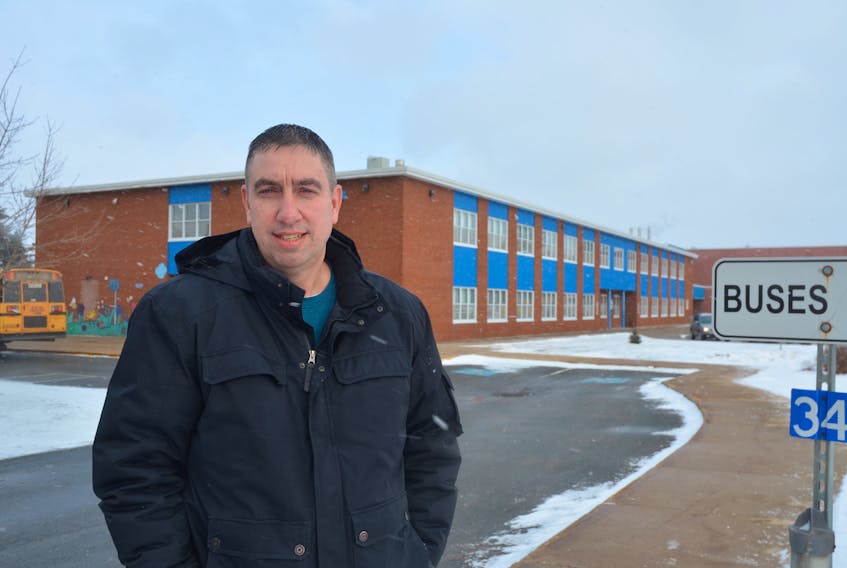NEW MINAS, NS - A concerned parent who wants to raise funds to purchase an AED for New Minas Elementary School (NMES) doesn’t understand why it would be a bad idea.
Alex Pudsey of North Alton, who has a daughter in Grade 4 at the school, said he has been attempting to get an AED (Automated External Defibrillator) into NMES but has essentially been blocked by the Annapolis Valley Regional Centre for Education (AVRCE) from doing so.
According to the Canadian Heart and Stroke Foundation, an AED is a small, portable and easy-to-use device that assesses the heart of a person in cardiac arrest for a shockable rhythm.
If such a rhythm is detected, the provider is instructed to press a button to deliver a shock or a series of shocks to the victim’s heart, stopping the heart to allow it to return to a normal rhythm. If no shockable rhythm is detected, no shock can be given and the provider must perform CPR until professional help arrives.
Pudsey said he was informed by the regional education centre’s communications officer that AED’s are placed in schools where required for a specific medical plan. This “feels short sighted” to him and he would suggest that in many if not most cases, students or faculty wouldn’t necessarily know they need one of the units until an emergency arises. By then, it’s often too late if there isn’t already an AED on site.
“I understand it’s not frequent, it doesn’t happen often, but it does happen sometimes,” Pudsey said.
He read a number of online articles about efforts undertaken in other school jurisdictions and in other provinces to place these devices in schools. Pudsey said reading about two very different outcomes – one where a life was lost because there wasn’t a defibrillator on hand and one where a life was saved by having an AED in a school – convinced him that there should be one at NMES.
“I contacted the principal to ask if they had one. They didn’t, so it kind of took off from there,” Pudsey said.
Although he didn’t directly ask the regional centre for education if he could procure an AED for NMES, he asked what the policy is. The response indicated to him that his initiative wouldn’t be successful because of current practices regarding AED’s.
Pudsey said the situation “boggles my mind.” What he finds most surprising about the refusal is that he was willing to raise funds to cover the cost. AED’s typically cost approximately $2,000. Every football season, Pudsey organizes a pool and donates the proceeds to the NMES breakfast program. He planned to use the proceeds from one of these football pools to hopefully cover the cost of the device.
He said it takes minimal time and effort to maintain today’s AED’s and it doesn’t take long to learn to use one. If these considerations don’t pose issues in schools where there is an identified health concern, there should be no problem placing an AED in any school. Today, the devices are “everywhere.”
Pudsey said he has contacted the office of the Minister of Education to see if there is a provincial policy regarding the placement of AED’s in elementary schools but he had yet to receive a response. The regional centre for education couldn’t speak to whether or not there is a policy in place provincially.
No policy, but practice in place
AVRCE communications and FOIPOP officer Kristen Loyst said via email that while they don’t have a policy, the practice in the Valley region has been to place an AED in a school when a student or staff member has an identified medical need and their doctor has recommended it.
“While we appreciate the perspective of school community members on this topic, at this time we are continuing our practice of installing these devices when required as part of a student or staff member’s medical care plan,” Loyst said.
In these cases, when placing an AED, the regional centre for education follows guidelines for the units as published by the Heart and Stroke Foundation of Canada. This includes but is not limited to how rescuers will access the AED and if the AED is in a secured location; how the unit will be maintained and who and how many people will be trained to use the AED.
Did you know?
According to the Heart and Stroke Foundation of Canada, combined with CPR, the use of an Automated External Defibrillator (AED) may increase the likelihood of saving a person’s life by 75 per cent or more over CPR alone.
RELATED:









